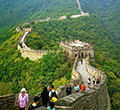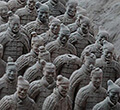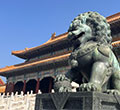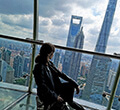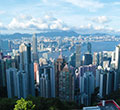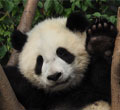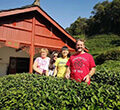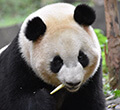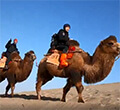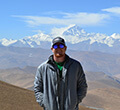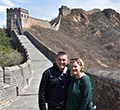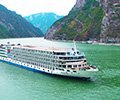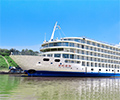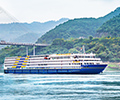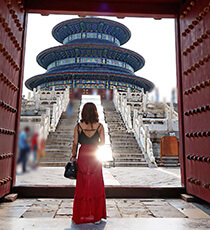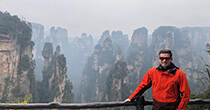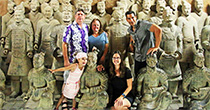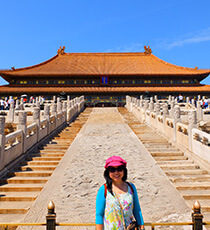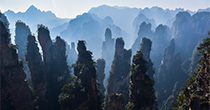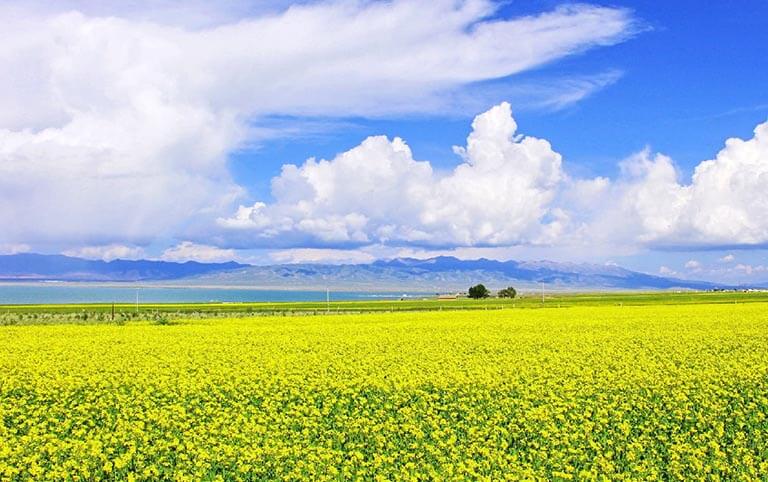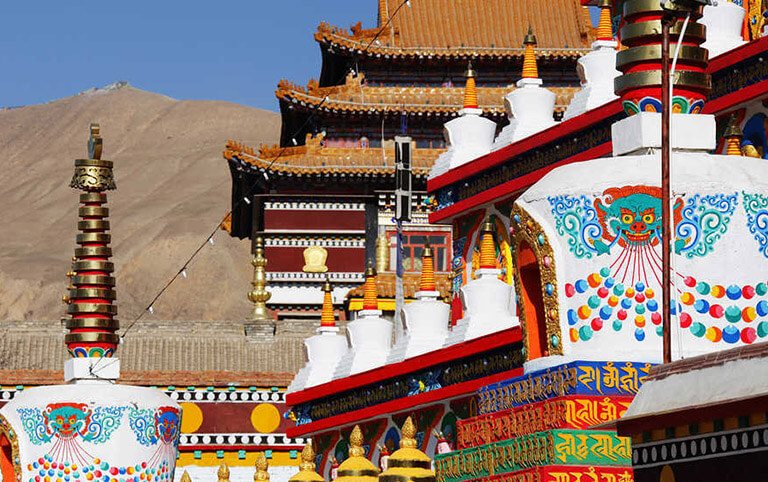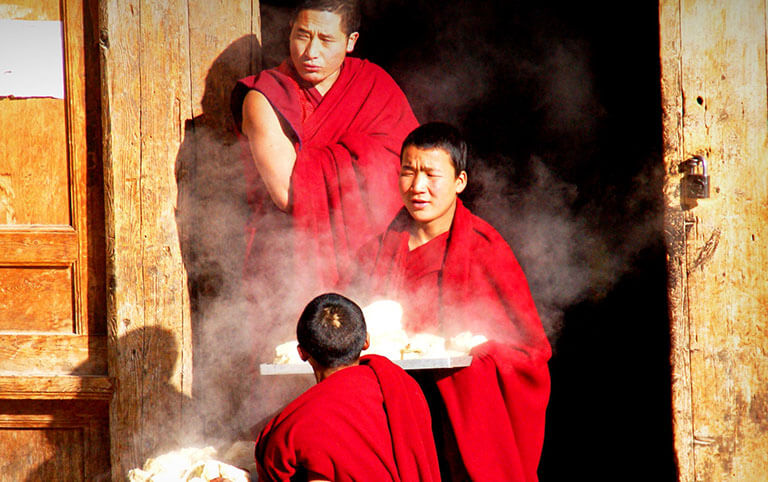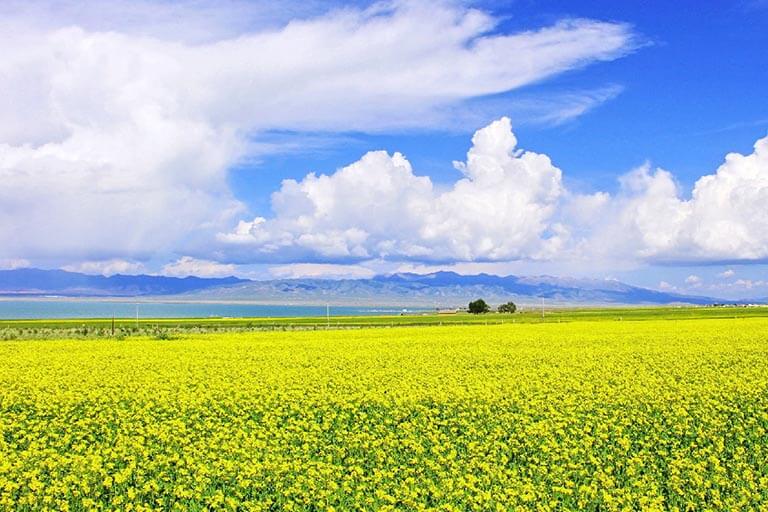Your tour - at a glance
Day 1~1 Arrival & Xining Qinghai Lake Tour
The Day 1 is free for you to arrive at Xining. On the Day 2, you will have a full day exploration of Qinghai Lake. Stay your night in Xining.
Day 3~5 Travel from Xining to Lanzhou
Travel from Xining to Tongren to explore Regong Art and Buddhist monasteries on the Day 3. Day 4 is to visit the famous Labrang Monastery and take an excursion to Sangke Grassland, and stay overnight in Linxia. On the Day 5, you will travel to Lanzhou city via Bingling Temple Grottoes.
Day 6~10 Travel from Lanzhou to Dunhuang
Take a high speed train to Zhangye to visit Zhangye Danxia Landform Geographical Park on the Day 6. On the Day 7, you will get to Jiayuguan to visit Jiayuguan Pass. Travel from Jiayuguan to Dunhuang, the final destination. In Dunhuang, you will have a full day exploration of Mogao Grottoes, Mingshashan and Crescent Lake. The Day 10 is free for you to depart from Dunhuang.
Full Itinerary Day by Day
Day 1 Xining Arrival
Welcome to Xining (altitude: 2,261 m), the capital city of Qinghai Province in northwestern China. Upon arriving at Xining Caojiabao Airport (or Xining Railway Station), your tour guide will meet you and escort you to your hotel in the downtown by a private vehicle. After checking in, the rest of today is on your own to acclimate to the elevation and explore this historical city of China.
Arrival Ideas: You can take a flight to Xining from Beijing (about 2hrs), Shanghai (about 3hrs), Xian (about 1.5hrs), Chengdu (about 2hrs), Guangzhou (about 3.5hrs), Dunhuang (about 1.5hrs), etc., or get to Xining by high speed bullet train from Xian (about 4hrs), Lanzhou (about 1.5hrs), Zhangye (about 2hrs), Jiayuguan (about 3~3.5hrs) and other connected cities in China.
Nightlife idea: go to enjoy a great dinner and stunning night view of Xining city on Pearl of Puning which is a 188 meters tall TV & Sightseeing tower alike Oriental Pearl Tower in Shanghai.
-
 Xining Railway Station
Xining Railway Station
Day 2 Xining – Qinghai Lake (B, L)
After breakfast, drive around 150 km (2.5 hours) to see the picturesque Qinghai Lake from Xining via Huangyuan, Riyue Mountain, etc. You won't feel bored along the driving since the fascinating scenery of green grassland, blue sky, white clouds and clustered herds unfold like a photo gallery. As the largest inland lake, as well as the largest salt water lake in China, Qinghai Lake (3200 m) stretches 105 km in length, 63 km in width and occupies a water area of over 4,500 square kilometers. It was elected as the Most Beautiful Lake in China by China’s National Geographic, attracting thousands of photographers to take photos every year.
You will spend a wonderful time appreciating the beauty of Qinghai Lake in Erlangjian Scenic Area - the essence of the whole scenic area of Qinghai Lake. It shapes like a long and narrow sword inserting into the lake. Walking on the plank road, you will be delivered a far-reaching panorama of the sea-like lake. Due to the different salt content of different parts of the lake, the water presents different colors in the refraction of sunlight. More than the lake view, the scenic surrounding - endless grassland and rapeseed flower lands, soft sand beaches as well as flocks of grazing sheep, horses and yaks also make you enjoy yourself to the fullest. On a clear day, you will feast your eyes on a charming vista of the snow-capped mountains in the distance as well as the huge sand dunes of Sand Island on the far shore. At the same time, Qinghai Lake is a sacred Tibetan Buddhist site. There are many devoted Buddhist coming from afar to worship to Qinghai Lake each year.
Optional Qinghai Lake Cruise: Taking a cruise allows you to admire Qinghai Lake from a different perspective. There are two kinds of cruises available in Erlangjian Scenic Area: High Speed Cruise and catamaran. The former offers a 25 minutes’ single trip from Erlangjian Wharf to Erlangjian Peninsula at the cost of CNY140. The latter offers a 50 minutes’ round trip at the cost of CNY180. This price doesn't include your personal expense on the ship, such as drinking, food, etc. This cruise is only available during the period from May to October.
After sightseeing, drive about 10 minutes to Viewing-deck in Nanshan Mountain for a panoramic view of Qinghai Lake. The beautiful shoreline is seen clearly and the water takes on bluer color. Then, drive back to Xining for accommodation.
Warm Tips: 1) It is available to visit Qinghai Lake all the year around, but May to October is the best time because of the most comfortable weather. If you want to savor the sea of rape flowers, remember to visit in July and August. 2) The sunlight is very strong in Qinghai Lake, and it is necessary to bring hat, sunglasses, sunscreen, etc. to protect your skin from sun burn especially in summer. 3) Few people get serious high altitude sickness in Qinghai Lake, but it is important to be wary of high altitude sickness if it's your first time to enter the high plateau. Avoiding strenuous exercise and drinking more water will be helpful.
-
 Qinghai Lake walking
Qinghai Lake walking
-
 Riyue Mountains
Riyue Mountains
-
 Enjoy a cruise on Qinghai Lake
Enjoy a cruise on Qinghai Lake
-
 Seagullings in Qinghai Lake (Erlangjian Scenic Area)
Seagullings in Qinghai Lake (Erlangjian Scenic Area)
Day 3 Xining – Tongren – Xiahe (B, L )
After breakfast, drive about 165km (2.5 hours) to Tongren, which is located in the southeastern upland of Qinghai Province.
Start exploration with a visit to Longwu Monastery which is one of the three most influential Tibetan monasteries in Amdo region with a history over 700 years, but barely visited by big tourist groups so that you can enjoy a peaceful Tibetan Buddhism inspiration here. Explore the resplendent Buddhist palaces, temples, halls, academies, stupa, and beautiful Thangka paintings to get inspired by the most authentic Tibetan culture in the region.
Move on to Wutong Monastery which outstands in a Tibetan village. It is in Wutong Monastery that the brilliant Regong Art originated and flourished. What makes the temple even more respectful is that Wutong Monastery has been teaching villagers of the area to create Regong Art for centuries, which helps Tongren become the Buddhist center of Amdo Tibetan region. So what is Regong Art? It is a collective art type which includes Thangka, Duixiu(embroidery), sculpture, architectural paintings, butter flowers and many other local art forms. The artists also attach great importance to originality. All the pigments are refined from mineral and plant juice. As the mother of Regong Art, Wutong Monastery collects numerous exquisite Regong art masterpieces. Next, you will go to a local Regong Painting School to observe closely how the teachers and students create Regong Art delicately.
After the meaningful Tibetan culture and art exploration, keep driving about 110km (2.5 hours) to Xiahe for accommodation.
-
 A Tibetan monk was painting Mandala in Wutong Monastery
A Tibetan monk was painting Mandala in Wutong Monastery
-
 Magnificent Wutong Monastery in Tongren
Magnificent Wutong Monastery in Tongren
-
 Tibetan monks' living in Longwu Monastery in Tongren
Tibetan monks' living in Longwu Monastery in Tongren
Day 4 Xiahe - Labrang Monastery - Linxia (B, L)
This morning you will go to visit Labrang Monastery, the most influential monastery outside the Xizang Autonomous Region and also one of the six great monasteries of the Gelug (Yellow Hat) school of Tibetan Buddhism. It is also famous for having the most complete Tibetan Buddhism teaching system in China. The monastery is large in scale and magnificent in architecture style, enshrining a lot of huge Buddha statues and various exquisite sculptures, murals and magical instruments. Its pilgrimage corridor has over 2000 prayer wheels, as the longest of its kind in the world. In the southwest corner of Labrang Monastery, there is an ancient wooden bridge. Walking crosses the bridge and walking up to the hill, you can enjoy a panoramic view of Labrang Monastery and surrounding.
In the afternoon, you will take an excursion to Sangke Grassland which is a natural pasture of Tibetan nomads. The grass is lush like a blanket in summer and the cattle and sheep are herding in groups under the blue sky and white clouds. What a pastoral scenery. Every year on July 13th of the lunar calendar, the seven tribes of Sangke region will gather at Sangke Grassland and hold a horse racing festival here.
After Sangke Grassland visit, drive about 2.5 hours to Linxia, the capital of the Linxia Hui Autonomous Prefecture. Check in to your hotel. The rest time is your free time to explore this beautiful city full of Muslim culture.
-
 Labrang Monastery
Labrang Monastery
-
 Sangke Grassland - a natural pasture of Tibetan nomads
Sangke Grassland - a natural pasture of Tibetan nomads
Day 5 Linxia - Bingling Temple - Lanzhou (B, L)
Today you will drive back to Lanzhou (about 3 hrs). On route, you will take a side trip to visit Bingling Temple, a Buddhist cave with a long history of over 1,600 years. First, you will drive about 1.5 hours to Liujiaxia Dam, a big national hydroelectric reservoir on the upper Yellow River. From the dock, you need to take a speed boat to get to Bingling Temple. During the 40-50 minutes’ boat ride, you can see a different section of Yellow River, very limpid and clear unlike the muddy sights seen in Lanzhou, and layered, red-colored huge Danxia landforms along the riverside, without coverage of any plantations.
After getting off from the boat, walk several minutes to the entrance of Bingling Temple. The temple is actually a site of Buddhist grottoes filled with ancient Buddhist frescoes and sculptures caved into the rocks, along a long narrow valley of Yellow River. Dating back to West Qin Kingdom, the cave preserves about 183 caves, 694 stone statues, 82 clay sculptures and more than 900 square meters murals. You will tour the most spectacular Lower Temple Area, seeing the 27-meter giant sitting Buddha, many colored Bodhisattvas in different gestures and remaining murals from Wei, Sui, Tang, Song, Yuan, Ming and Qing Dynasties. Though some figures have been damaged by earthquakes, erosion, these relics are unquestionably outstanding Buddhist artworks revealing previous Buddhism prosperity and remarkable architecture and carving art of ancient China.
After sightseeing, leave Bingling Temple and drive back to Lanzhou. Check in to your hotel. The rest of today is free for you to explore this city of Yellow River.
Tips: 1. Bingling Temple in remote mountain area can only be reached by waterway in summer and autumn via Liujiaxia Dam. 2. Additional fees will be charged for visiting special caves. 3.)Be careful when walking up the serpentine plank trail on the cliff.
-
 Take a boat on Liujiaxia Dam to visit Bingling Temple Grottoes
Take a boat on Liujiaxia Dam to visit Bingling Temple Grottoes
-
 Bingling Temple Grottoes
Bingling Temple Grottoes
Day 6 Train to Zhangye (B, L)
After breakfast, you will take a morning high speed train to Zhangye city from Lanzhou (about 3.5 hrs). Enjoy the beautiful landscape along the road. After arriving at Zhangye West Railway Station, you will be met by a local tour guide. Let's get ready for the trip!
In the afternoon, drive about an hour to visit the Zhangye Danxia Landform Geographical Park. The Danxia landform is a spectacular petrographic geomorphology landscape which is formed from red-coloured sandstones and conglomerates. The one in Zhangye was formed in the pre-Jurassic Age. Thousands of mountains and stiffs stretch like the colorful sunset glow. The barren mountains are covered by a red grit rock stratum. At the same time, some surfaces of mountains appear in other colors, such as white, yellow, etc, and form many irregular lines and blocks looking like some abstract oil paintings. There are viewing decks for you to watch and shoot. You will visit one by one, and will be transferred by park buses from one deck to another.
You won't miss the precious opportunity to enjoy the amazing sunset. Viewing Deck No. 4 (七彩红霞台) is the best location to take the sunset of the Danxia Landform. It's better to get there earlier to occupy a good location. After sunset, drive back to Zhangye downtown for accommodation.
Tips:
1. Pack with sunblocks, sunglasses, protective clothing and hat to protect from strong sunlight in summer; 2. Sunset is the best time for taking photos, which happens around 19:00~20:00 in summer and 18:00~19:00 in winter.
-
 Zhangye Danxia Landform Views After Rain
Zhangye Danxia Landform Views After Rain
-
 Zhangye Danxia Landform Photography
Zhangye Danxia Landform Photography
Day 7 Zhangye - Jiayuguan (B, L)
After breakfast, you will go to visit the Giant Buddha Temple, which is famous for having the largest indoor sleeping Buddha in Asia. This temple is a large complex with regal arrangements built in the Xixia Dynasty(1098), and keeps many precious Buddhist scriptures and wall paintings. Its famous treasure is the Sleeping Buddha, which is centrally seated with symmetric buildings situated along both sides. The Buddha statue was carved by wood with a length of 34.5 meters, telling the story of Buddha's Nirvana. His ears are as big as the space in which 4 adults can sit side by side.
After visiting the Buddha Temple, drive about 220 km (2.5hrs) to Jiayuguan City and check into your hotel. Then you will go to visit "the First and Greatest Pass under Heaven", also the westernmost starting point of the Great Wall of Ming Dynasty - Jiayuguan Pass. Start your exploration with an educational visit to the Great Wall Museum to learn some interesting facts about both the Jiayuguan Fort and Great Wall, including history, old photos, relics, etc. Then enter the gate to explore the grandiose Jiayuguan Fort. It is a complex of towers, city walls and other military buildings covering more than 25,000 square meters. The city wall is nearly 11 meters high, and comprises an outer and inner wall. There are two large gates standing at the east and the west of the inner wall. Walkways lead to the top of the wall, allowing horses to climb up the wall.
If time allows, and you are interested, you can take an optional visit to the Xuanbi Great Wall (Overhanging Wall) which is about 18km away from the Fort. The walls were built on lofty cliffs with incredibly large gradients looking like an overhanging cantilever. Climbing up to higher gives you excellent views of the surrounding land and mountains.
-
 Jiayuguan Fort
Jiayuguan Fort
-
 Giant Buddha Temple
Giant Buddha Temple
Day 8 Jiayuguan - Dunhuang (B, L)
Today you will travel to Dunhuang from Jiayuguan in the early morning. On route, visit Yulin Grottoes which is known as the "sister caves" of Mogao caves. It is a Buddhist cave temple site located about 160 km east of the oasis town of Dunhuang and the Mogao Caves, and was listed as the UNESCO World Heritage sites as part of the Chinese Section of the Silk Road. There are 43 existing caves in the Yulin Caves, with a total of 5,200 square meters of murals and more than 259 colored sculptures. You can visit up to 5 caves in which you can admire magnificent mural paintings which are believed to be even more beautiful than those in Mogao Caves. There are also 4 “special caves” (No. 2, No. 3, No. 4 and No. 25) with outstanding art value that you can visit with extra charges.
After arriving at Dunhuang city, check in to your hotel.
Nightlife Idea: go out for a walk in the Shazhou Night Market where you can try some local food, relax in a drinking bar, or buy some interesting handcrafts, etc.
-
 Yulin Grottoes (No. 3 Cave)
Yulin Grottoes (No. 3 Cave)
-
 Bustling Shazhou Night Market
Bustling Shazhou Night Market
Day 9 Dunhuang Mogao Grottoes Exploration & Mingshashan Sightseeing (B, L)
After breakfast, drive about 10km from the Dunhuang city to visit the newly opened Mogao Grottoes Digital Exhibition Center before go to Mogao Grottoes. You will watch two short but well-produced educational documentary movies that introduce the history, arts, and other facts about Mogao Grottoes. After the movies, take the interzonal bus to Mogao Grottoes.
Mogao Grottoes is famed as the "Louvre of the East", which is outstanding for its exquisite mural paintings and statues. There are now 492 grottoes in which about 45000 square meters mural paintings and 2100 colorfully painted statues from which you can trace the development of Chinese art over 1600 years from one dynasty to the next because each dynasty built own caves to record its own features. There are about 40 common caves opened to the public. In the tourist area, you will be divided into groups by different tour guides who will accompany you to visit the caves (usually 7~8 caves during April~November and 12 caves during December~March) with great introduction. After that, if you want to visit more other caves, you can do it by yourselves or follow other tour guides. Besides, there are 10 special caves (with extra fees) available for your extensional visiting. To protect the mural paintings, it is not allowed to take photos or use any flashlight inside the Mogao grottoes.
The following attraction is Mingshashan, the Echoing Sand Mountains. It is said, in the sunny days, the sand mountains echo like Orchestra music even if there is no wind. If you slide from the sand mountains, you can hear the echoing sound clearly. Your last thing to do for today is the Crescent Lake. Surrounded by the Echoing Sand Mountains, Crescent Lake is a beautiful oasis with some well decorated traditional Chinese architecture, some trees and flowers and a lake that has never dried up and shapes like a crescent moon.
In the summer, travelers can stay up to late night around 21:30 in Mingshashan Scenic Area to enjoy the cool time and beautiful sky of stars. It's usually very hot during 12:00~15:00. You can enter the park later when it is not that hot.
Free Time Nightlife Ideas: Enjoy the fascinating Silk Road Show - Ancient Sound of Dunhuang. Through the use of high-tech methods such as holographic projection and 3D visuals, it presents a fully immersive theatrical experience of both elaborate dances and unique performance of ancient musical instruments.(Notice: the Silk Road Show is not available during November to middle April of next year. The tickets of the show sell out quickly. If you want to watch the show, please let your travel consultant or tour guide know in advance.)
-
 Echoing Sand Mountains
Echoing Sand Mountains
-
 Watch a documentary film in the Dome Theater of Mogao Grottoes Digital Exhibition Center
Watch a documentary film in the Dome Theater of Mogao Grottoes Digital Exhibition Center
-
 the Mogao Grottoes in Dunhuang
the Mogao Grottoes in Dunhuang
Day 10 Dunhuang Departure (B)
Today is free for you until your tour guide see you off at the airport/train station.
Tips: remember to pack all your belongings carefully, and check out your hotel before 12:00 or extra cost may occur.
Make an Inquiry for Free
Recommended Add-on Options
Visa Notice for Traveling to China
2025/2026 China Tour Visa-friendly Policies:
1. China has launched a 30 Days Visa-free Policy for 38 eligible countries, including several European nations — Andorra, Austria, Belgium, Bulgaria, Croatia, Cyprus, Denmark, Estonia, Finland, France, Germany, Greece, Hungary, Iceland, Ireland, Italy, Latvia, Liechtenstein, Luxembourg, Malta, Monaco, Montenegro, the Netherlands, North Macedonia, Poland, Portugal, Romania, Slovakia, Slovenia, Spain, and Switzerland. In Oceania, Australia and New Zealand are listed, while in Asia, Malaysia, South Korea, Brunei, and Japan are included. This policy is valid till December 31, 2025. Read more »
2. 10 days visa free (transit) for 54 eligible countries include the US, UK, Canada, Brazil, etc. Eligible travelers can now travel across provinces, for example traveling from Beijing to Xian, then to Shanghai. Mohan Railway Port at China-Laos border can be used to enter/leave Yunnan. Hong Kong High-speed Rail West Kowloon Station has been added to Guangdong Province 144-hour transit visa-free. Read more »
3. As of now, China has established full visa exemption agreements with 25 countries, including Asian countries: Thailand, Singapore, Maldives, Kazakhstan, the UAE, Qatar, Armenia, Georgia; European countries: Albania, Belarus, Bosnia and Herzegovina, Serbia, San Marino; African countries: Mauritius, Seychelles; Oceania countries: Fiji, Tonga, Solomon Islands; North American countries: Antigua and Barbuda, Barbados, Dominica, Ecuador, Grenada, Bahamas; South American country: Suriname.
4. Booking of flights and hotels, China itineraries and invitation letters are not required for application of Chinese Tourist Visa for U.S.nationals.
5. Appointment is not required for visa application in many embassies and consulates.
Practical Info about Traveling with Us
Restaurant & Food
Vegetarian food Requirement
Vegetarian food in Chinese cuisine culture is usually divided into 3 categories: the Monastery
Vegetarian
Food, the Court Vegetarian Food and the Folk Vegetarian Food. And the main ingredients are:
soybean,
taro powder, mushrooms, fresh vegetables and tofu (bean curd). It will be easier to find the
vegetarian
restaurants in big cities of china, such as: Beijing, Shanghai, Xian, HK, etc.
If allergic to some food
We suggest you to list any food or ingredients that you are allergic to and let our travel
consultant
know. Then your travel consultant will mark them in the guide’s itinerary, so that our guides
in
different cities can make some preparations and arrangements in advance.
Do our guide and driver join the meal with us?
The tour guides and driver will be at the same restaurants with you, but they will only join the
meal
when you invite. Sometimes the drivers are shy to join as they usually eat fast and could not
understand
English talk around the table, so the guide will be with you more often.
Will we be able to try some local foods during our visit?
Yes, you will. There will be some meals excluded in your itinerary as you like, and your private
guide
will be delighted to give you some suggestions and take you to the local restaurants, if you
are
interested in local food tasting. But remember, some local snacks may not match your stomach,
so
ask your guided for more information before eating.
Shopping
What to buy in China?
In China, there are myriads of souvenirs for visitors, and each city has its own specialty.
How to bargain?
Bargains are not acceptable in big supermarkets and department stores. But in some night markets
or tourist
shops, you can bargain for a lower price, since the vendors always ask for very high price for
a
certain item. You’d better ask the opinion of the guide first, and then the guide will tell you
the
real value and quality of the item. Please note that when the bargain is processing, the guide
will
be hesitate to help as it may annoy the bosses. Just try to let the guides know you will
bargain
in advance.
What to do with persistent vendors?
If you do not need something from them, just do not ask for price. Some of the venders are very
persisted,
and if they keep selling things to you, you can simply say “No, thanks.” (Chinese
pronunciation:
”Bu, XieXie”). If they do not give up, you just keep silence. Silence is sometimes useful to
handle
this situation.
Private tour features
- 1. Private guide, driver and vehicle are for your exclusive use; no matter you are
individually,
or in a family or friends group. The tour is run exclusively for you without strangers.
- 2. Every itinerary can be customized to meet your specific interests/ wishes, that is, you
can choose
your favored hotels, sightseeing spots, the tour length, means of transportation, budget,
etc.
All are free of charge.
- 3. Start the tour on any date you want.
- 4. Escort you through the whole tour. All private transfers during the tour are offered,
including
airport/train station transfer, hotel-attractions round trip transfer.
- 5. The sightseeing during the tour could be based on your own timetable and pace. Flexible
to change
at your short notice.
- 6. Ideal for people who need considerate care and assistance, such as elderly, the
disabled, families
with small children.
Emergency calls
Call your guide, or if you can’t find your guide, call your travel consultant or our office
immediately.
All the phone numbers include in our confirmation letter. Keep the letter with your during your
trip.
